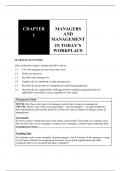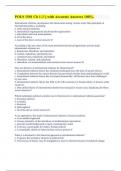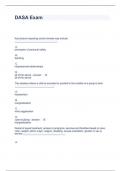CHAPTER MANAGERS
1 AND
MANAGEMENT
IN TODAY’S
WORKPLACE
LEARNING OUTCOMES
After reading this chapter, students should be able to:
1-1. Tell who managers are and where they work.
1-2. Define management.
1-3. Describe what managers do.
1-4. Explain why it’s important to study management.
1-5. Describe the factors that are reshaping and redefining management.
1-6. Describe the key employability skills gained from studying management that are
applicable to your future career, regardless of your major.
Management Myth
MYTH: Only those who want to be managers need to take a course in management.
TRUTH: Anyone who works in an organization—not just managers—can gain insight into
how organizations work and the behaviors of their boss and coworkers by taking a course in
management.
SUMMARY
Everyone seems to think they know what makes a good leader. They think it is common sense,
but you don’t have to be a manager, or aspire to be a manager, in order to gain something from
a management course.
Teaching Tips:
Get students to give some examples of good managers. Ask if it matters if the manager is young
or old, male or female? Is management necessary in non-profit organizations and small
companies like it is in for-profit and large companies?
,I. WHO ARE MANAGERS, AND WHERE DO THEY WORK?
A. Introduction
1. Managers work in an organization.
2. An organization is a deliberate arrangement of people brought together to accomplish
some specific purpose.
a) Your college or university is an organization. So is a football team and a sorority.
B. What Three Characteristics Do All Organizations Share?
1. Every organization has a distinct purpose and is made up of people who are grouped
in some fashion.
a) See Exhibit 1-1.
b) This distinct purpose is typically expressed in terms of a goal or set of goals.
2. Purposes or goals can only be achieved through people.
3. All organizations develop a systematic structure that defines and limits the behavior
of its members.
a) Developing a structure may include creating rules and regulations, giving some
members supervisory control, forming teams, etc.
C. How Are Managers Different from Nonmanagerial Employees?
1. Organizational members fit into two categories: nonmanagerial employees and
managers.
a) Nonmanagerial employees work directly on a job or task and have no oversight
on the responsibility of others.
b) Managers direct the activities of other people in the organization.
1) Customarily classified as top, middle, or first line, they supervise both
nonmanagerial employees and lower-level managers.
2) See Exhibit 1-2.
3) Some managers also have nonmanagerial responsibilities themselves.
2. The distinction between non-managers and managers is that managers have
employees who report directly to them.
, Classic Concepts in Today’s Workplace
The terms management or manager come from a number of sources. One source says that the
word manager originated in 1588 to describe one who manages. The specific use of the word as
“one who conducts a house of business or public institution” is said to have originated in 1705.
Another source says that the origin (1555–1565) is from the word ‘maneggiare,’ which meant
“to handle or train horses,” and was a derivative of the word mano, which is from the Latin word
for hand, manus. This origin arose from the way that horses were guided, controlled, or directed
where to go—by using one’s hand.
The words management and manager are more appropriate to the early twentieth century. Peter
Drucker, the late management writer, studied and wrote about management for more than 50
years. The word management was first popularized by Frederick Winslow Taylor. In 1911,
Taylor’s book Principles of Scientific Management was published. Its contents were widely
embraced by managers around the world. The book described the theory of scientific
management: the use of scientific methods to define the “one best way” for a job to be done.
He spent more than two decades passionately pursuing the “one best way” for such jobs to be
done. Based on his groundbreaking study of manual workers using scientific principles, Taylor
became known as the “father” of scientific management. Some of these techniques like the
analysis of basic work that must be performed and time-and-motion studies are still used today.
D. What Titles Do Managers Have?
1. Top managers are responsible for making decisions about the direction of the
organization and establishing policies that affect all organizational members.
a) Top managers have titles including vice president, managing director, chief
operating officer, chancellor, etc.
2. Middle managers represent levels of management between the first-line supervisor
and top management.
a) They manage other managers and possibly some nonmanagerial employees.
b) They are responsible for translating the goals set by top management into specific
details.
3. First-line managers are usually called supervisors, shift managers, etc.
a) They are responsible for directing the day-to-day activities of nonmanagerial
employees.
4. Team leaders are responsible for managing and facilitating activities of a work team.
a) They typically report to a first-line manager.
II. WHAT IS MANAGEMENT?
1. Management can be defined as the process of getting things done effectively and
efficiently, through and with other people.
a) The term “process” in the definition represents the primary activities managers
perform.
2. Effectiveness and efficiency deal with what we are doing and how we are doing it.
, a) Efficiency means doing the task right and refers to the relationship between inputs
and outputs. Management is concerned about minimizing resource costs while
achieving the desired output.
b) Effectiveness means doing the right task, and in an organization, that translates
into goal attainment.
c) See Exhibit 1-3.
3. Efficiency and effectiveness are interrelated.
a) It’s easier to be effective if one ignores efficiency.
b) Good management is concerned with both the attainment of goals (effectiveness)
and efficiency in the process.
III. WHAT DO MANAGERS DO?
A. Describing what managers do is a difficult task
1. While the job of manager varies from organization to organization, they do share
some common elements.
2. Management researchers have developed three approaches to describe what
managers do: functions, roles, and skills/competencies.
B. The 4 Functions Approach
1. See Exhibit 1-4; planning, organizing, leading, and controlling.
2. These processes are interrelated as well as interdependent.
3. Planning encompasses defining an organization’s goals, establishing an overall
strategy for achieving those goals, and developing plans to coordinate activities.
4. Organizing—determining what tasks are to be done, who is to do them, how the
tasks are grouped, who reports to whom, and where decisions are to be made.
5. Directing and coordinating people is the leading component of management.
a) Leading involves motivating employees, directing the activities of others,
selecting the most effective communication channel, and resolving conflicts.
6. Controlling.
a) To ensure that things are going as they should, a manager must monitor the
organization’s performance.
b) Actual performance must be compared with the previously set goals.
c) Any significant deviations must be addressed.
d) Monitoring, comparing, and correcting are the controlling process.
MyLab Management Try It!: If your instructor has assigned this activity, go to
www.pearson.com/mylab/management to complete the writing assignment.






